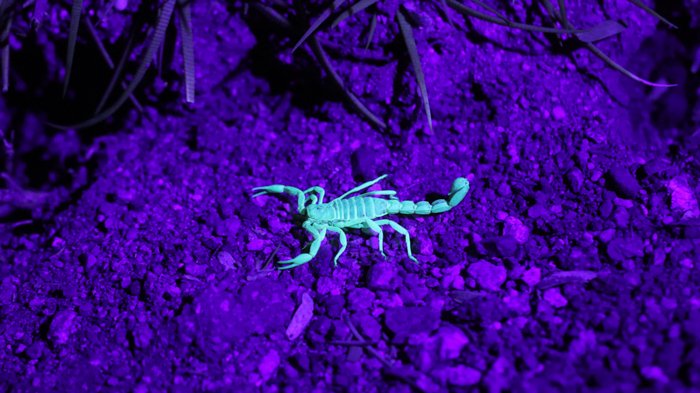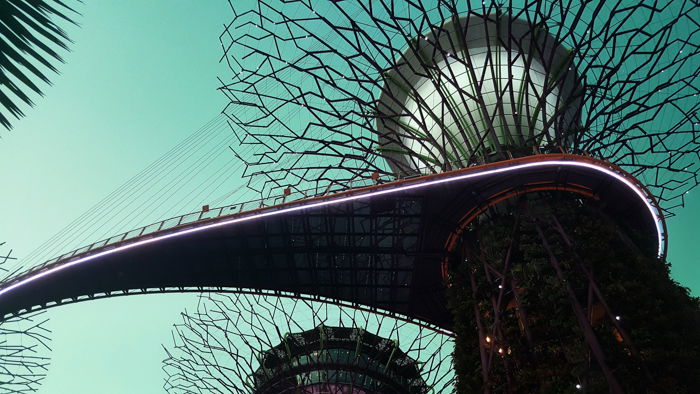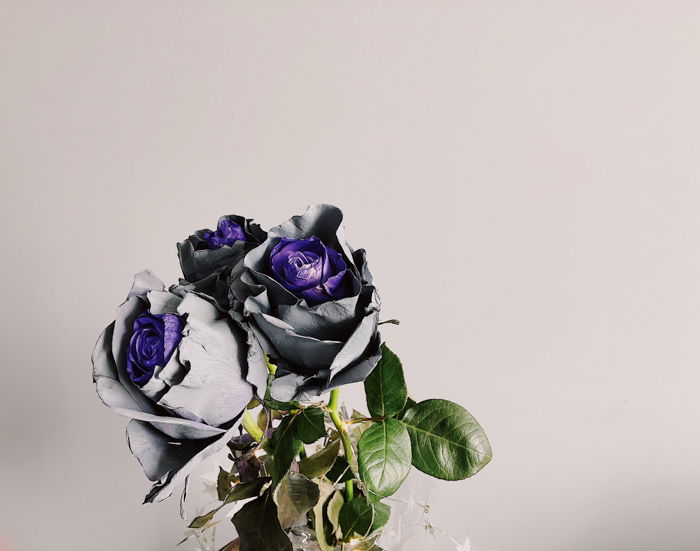We have all the information on what UV photography is and how you can use it to capture your own amazing images.
What Is UV Photography?
To understand what ultraviolet photography is, we need to look at UV from a basic level. You may hear the term ultraviolet spectrum, which is connected to the physics of photography. All light we see through our viewfinders comes in a spectrum. This is the visible light, which our eyes are built to see. This range is measured in nanometers, and the visible range is between 400 and 700 nm. Ultraviolet light falls short of this visible light spectrum, meaning we cant see it. It ranges from a wavelength of 320 to 400 nm. Although we can’t see it with our eyes, we can capture it with film and sensors. Just like infrared photography, the cameras we use need to be modified for UV photography. But, unlike IR photography, ultraviolet photography is more frequent in forensic photography and medical analysis. However, both can have their creative and artistic purposes, taking a step away from the usual portrait or landscape photography.
What Do I Need for UV Photography?
There are a few things you need to capture UV photography. First, You need to decide on whether you want to capture on film using an analog camera or on a digital sensor. If you choose film, then you have a further question of black and white or color. Film photography presents one option for capturing ultraviolet photography, and that is using a filter. Digital photography will allow you the option of modifying your camera by way of a full-spectrum conversion. This conversion will let you capture IR and UV photography. Filters aren’t possible with digital cameras as their lenses are coated with a special anti-ultraviolet coating. You can’t bypass this unless your camera is full-spectrum converted. There are ways around it. One of them is buying specific lenses without the coating or using analog lenses via an adapter. These old lenses or entry-level lenses are usually cheaper, which is a great benefit. And that’s it. Apart from a camera, filter and/or lenses, you’re ready to go. This is where I tell you that you can manipulate your pictures digitally to resemble UV photography. But, there’s nothing like doing UV photography for real.
How Do You Take UV Photos?
Taking ultraviolet photography images is a simple process. You can capture landscapes, portrait sessions, and even street photography. There are a few things we need to look at to ensure we take the best pictures possible. Using digital UV photography can have its benefits. You get to use Live View to compose and frame your shot. It will also help with focusing and stops you from damaging your eyes. NB: DO NOT use the viewfinder when using the Ultraviolet transmitting bandpass filter. This will inevitably damage your eyes. The same goes for the Ultraviolet bandpass filter when separated from the lens. If you’re using analog UV photography, you have to capture the images a little differently. You’ll need to compose and focus the shot without the filter, and then place it back when you have your scene set. Using manual focus will prevent refocusing when the lens is attached. This method may present some focus shifting due to the lens you are using. Take it into account if you are presented with this issue. Next, and one of the most significant areas in UV photography, is the white balance. First, shoot in Raw, so that you can recover detail and color casts if need be. It is helpful to use a grey card to ensure a correct white balance. This will stop or reduce any color casts that present themselves in your UV photography scene. As far as light sources go, the sun – and therefore every type of natural light – provides UV radiation. Sunglasses block it out, and even to some extent, so does glass. For a stronger UV light source, you need to use a flash, UV torch, or blacklight tube.
Common UV Photography Questions
How Does a UV Camera Work?
UV cameras work by allowing you to see some of the light spectrum that you don’t usually see. This is the UV wavelength, ranging from 320 to 400 nm. These wavelengths fall short of the visible light. They share some similarities with infrared, which comes just after what we are able to see with our eyes. There are two ways we can adapt a camera to take Ultraviolet pictures. First, especially when it comes to analog or film cameras, we can use a filter. The filter is of a low pass variety, letting through the ultraviolet light rays. This works with film photography, as the lenses are older and are not coated with Ultraviolet protection. With a digital photography camera, you need to convert it to see the UV rays. A full-spectrum conversion is when the camera’s internal IR filter is replaced with clear glass. This is useful for many areas of photography, including astrophotography, as well as improving the tonal range in B&W photography. By removing the filter inside the camera, you are free to experiment with all kinds of filters. This is made possible as the filter inside also opens up the camera for IR photography too.
Can Cameras See UV Light?
To understand if cameras can see UV light, we need to make a distinction between analog and digital cameras. They both are sensitive to UV light, but modern analog camera lenses hold filters that block out light from parts of the spectrum. They need to limit the amount of radiation that enters your camera, ensuring a better shot. Older lenses, such as those from a pre-WWII, lack coating, and therefore allow more UV light to pass through. Modern photographic film isn’t sensitive to UV wavelengths. Black and white film is more sensitive and can be seen to reach below 300 nm. Color slide film, except for Kodak Aerochrome, suppresses UV wavelengths. Cameras can see light wavelengths that fall below the visible spectrum. But, they have been treated in ways that stop the UV radiation from unnecessarily affecting your film or sensor.
Are Black Lights and UV Lights the Same Thing?
UV light can be and is referred to as black light. But, we also call any light wavelengths outside our visible spectrum black light. Let’s put it another way. UV light is black light, but not all black lights are UV. A black-light emits UV light and radiation. Some might see these lights used on TV on television shows and movies. Detectives walk into a crime scene and use these black lights to reveal hidden clues. What makes them black is a phosphorescent coating that allows the UV radiation to spread.
Do I Need a UV Filter for My Camera?
A UV filter blocks light from sources that present UV wavelengths, which are shorter than the wavelengths we are able to see. There are photographic films and old camera lenses that are still sensitive to this light. The UV filter stops the blue haze that comes with this type of radiation. For modern cameras, UV protection comes in the form of IR filters that sit in your camera. As we photograph nowadays, we don’t have the same sensitivity problems. This means we no longer need UV filters, unless using a camera or lens from pre-WWII. They do provide you with one benefit, and that is increased protection. If you have a UV filter, it will add an extra layer of protection to your lens. Better to scratch or bump this filter than your expensive lens. This, however, will slightly reduce your image quality, and you might not be able to see through it to frame and focus.






title: “What Is Uv Photography Easy Tips To Get Started " ShowToc: true date: “2023-01-15” author: “Jessie Damelio”
We have all the information on what UV photography is and how you can use it to capture your own amazing images.
What Is UV Photography?
To understand what ultraviolet photography is, we need to look at UV from a basic level. You may hear the term ultraviolet spectrum, which is connected to the physics of photography. All light we see through our viewfinders comes in a spectrum. This is the visible light, which our eyes are built to see. This range is measured in nanometers, and the visible range is between 400 and 700 nm. Ultraviolet light falls short of this visible light spectrum, meaning we cant see it. It ranges from a wavelength of 320 to 400 nm. Although we can’t see it with our eyes, we can capture it with film and sensors. Just like infrared photography, the cameras we use need to be modified for UV photography. But, unlike IR photography, ultraviolet photography is more frequent in forensic photography and medical analysis. However, both can have their creative and artistic purposes, taking a step away from the usual portrait or landscape photography.
What Do I Need for UV Photography?
There are a few things you need to capture UV photography. First, You need to decide on whether you want to capture on film using an analog camera or on a digital sensor. If you choose film, then you have a further question of black and white or color. Film photography presents one option for capturing ultraviolet photography, and that is using a filter. Digital photography will allow you the option of modifying your camera by way of a full-spectrum conversion. This conversion will let you capture IR and UV photography. Filters aren’t possible with digital cameras as their lenses are coated with a special anti-ultraviolet coating. You can’t bypass this unless your camera is full-spectrum converted. There are ways around it. One of them is buying specific lenses without the coating or using analog lenses via an adapter. These old lenses or entry-level lenses are usually cheaper, which is a great benefit. And that’s it. Apart from a camera, filter and/or lenses, you’re ready to go. This is where I tell you that you can manipulate your pictures digitally to resemble UV photography. But, there’s nothing like doing UV photography for real.
How Do You Take UV Photos?
Taking ultraviolet photography images is a simple process. You can capture landscapes, portrait sessions, and even street photography. There are a few things we need to look at to ensure we take the best pictures possible. Using digital UV photography can have its benefits. You get to use Live View to compose and frame your shot. It will also help with focusing and stops you from damaging your eyes. NB: DO NOT use the viewfinder when using the Ultraviolet transmitting bandpass filter. This will inevitably damage your eyes. The same goes for the Ultraviolet bandpass filter when separated from the lens. If you’re using analog UV photography, you have to capture the images a little differently. You’ll need to compose and focus the shot without the filter, and then place it back when you have your scene set. Using manual focus will prevent refocusing when the lens is attached. This method may present some focus shifting due to the lens you are using. Take it into account if you are presented with this issue. Next, and one of the most significant areas in UV photography, is the white balance. First, shoot in Raw, so that you can recover detail and color casts if need be. It is helpful to use a grey card to ensure a correct white balance. This will stop or reduce any color casts that present themselves in your UV photography scene. As far as light sources go, the sun – and therefore every type of natural light – provides UV radiation. Sunglasses block it out, and even to some extent, so does glass. For a stronger UV light source, you need to use a flash, UV torch, or blacklight tube.
Common UV Photography Questions
How Does a UV Camera Work?
UV cameras work by allowing you to see some of the light spectrum that you don’t usually see. This is the UV wavelength, ranging from 320 to 400 nm. These wavelengths fall short of the visible light. They share some similarities with infrared, which comes just after what we are able to see with our eyes. There are two ways we can adapt a camera to take Ultraviolet pictures. First, especially when it comes to analog or film cameras, we can use a filter. The filter is of a low pass variety, letting through the ultraviolet light rays. This works with film photography, as the lenses are older and are not coated with Ultraviolet protection. With a digital photography camera, you need to convert it to see the UV rays. A full-spectrum conversion is when the camera’s internal IR filter is replaced with clear glass. This is useful for many areas of photography, including astrophotography, as well as improving the tonal range in B&W photography. By removing the filter inside the camera, you are free to experiment with all kinds of filters. This is made possible as the filter inside also opens up the camera for IR photography too.
Can Cameras See UV Light?
To understand if cameras can see UV light, we need to make a distinction between analog and digital cameras. They both are sensitive to UV light, but modern analog camera lenses hold filters that block out light from parts of the spectrum. They need to limit the amount of radiation that enters your camera, ensuring a better shot. Older lenses, such as those from a pre-WWII, lack coating, and therefore allow more UV light to pass through. Modern photographic film isn’t sensitive to UV wavelengths. Black and white film is more sensitive and can be seen to reach below 300 nm. Color slide film, except for Kodak Aerochrome, suppresses UV wavelengths. Cameras can see light wavelengths that fall below the visible spectrum. But, they have been treated in ways that stop the UV radiation from unnecessarily affecting your film or sensor.
Are Black Lights and UV Lights the Same Thing?
UV light can be and is referred to as black light. But, we also call any light wavelengths outside our visible spectrum black light. Let’s put it another way. UV light is black light, but not all black lights are UV. A black-light emits UV light and radiation. Some might see these lights used on TV on television shows and movies. Detectives walk into a crime scene and use these black lights to reveal hidden clues. What makes them black is a phosphorescent coating that allows the UV radiation to spread.
Do I Need a UV Filter for My Camera?
A UV filter blocks light from sources that present UV wavelengths, which are shorter than the wavelengths we are able to see. There are photographic films and old camera lenses that are still sensitive to this light. The UV filter stops the blue haze that comes with this type of radiation. For modern cameras, UV protection comes in the form of IR filters that sit in your camera. As we photograph nowadays, we don’t have the same sensitivity problems. This means we no longer need UV filters, unless using a camera or lens from pre-WWII. They do provide you with one benefit, and that is increased protection. If you have a UV filter, it will add an extra layer of protection to your lens. Better to scratch or bump this filter than your expensive lens. This, however, will slightly reduce your image quality, and you might not be able to see through it to frame and focus.





